Research & Efficacy
50 Years of Proven Effectiveness
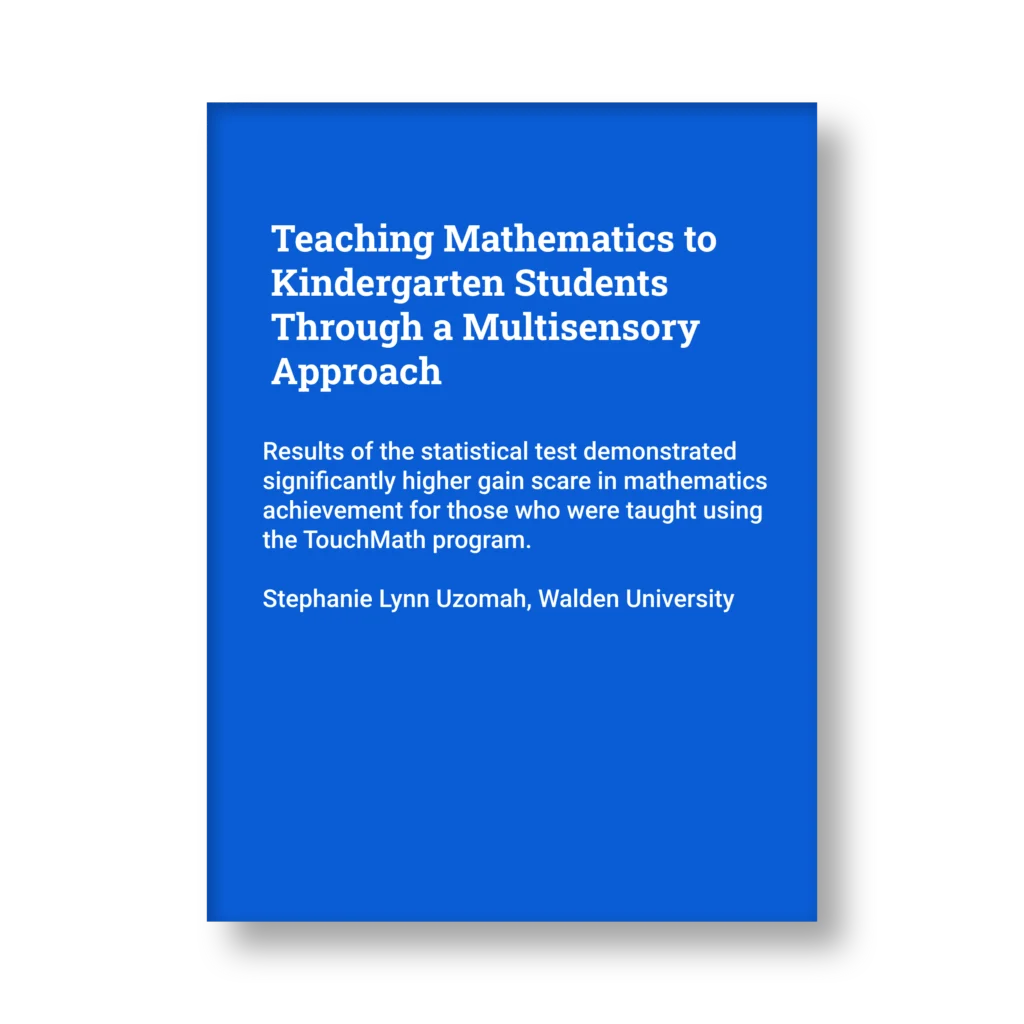
Teaching Mathematics to Kindergarten Students
Results demonstrated significantly higher gain scare in mathematics achievement for those who were taught using the TouchMath program.
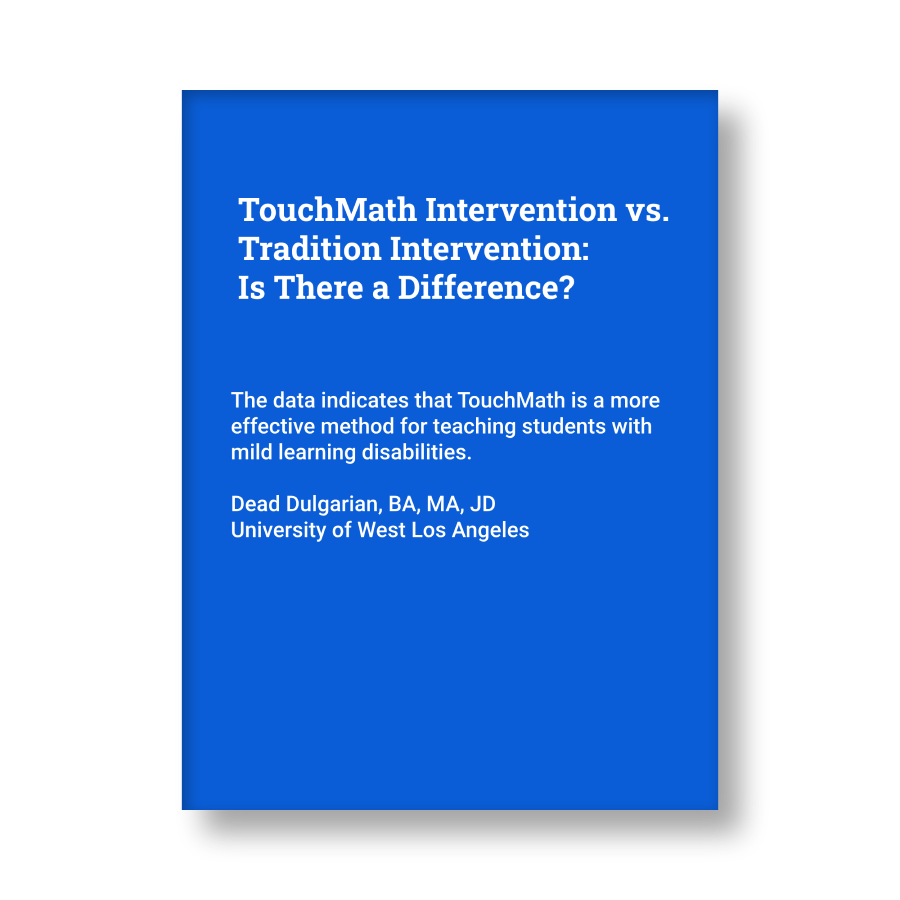
TouchMath Intervention vs. Traditional Intervention: Is There a Difference?
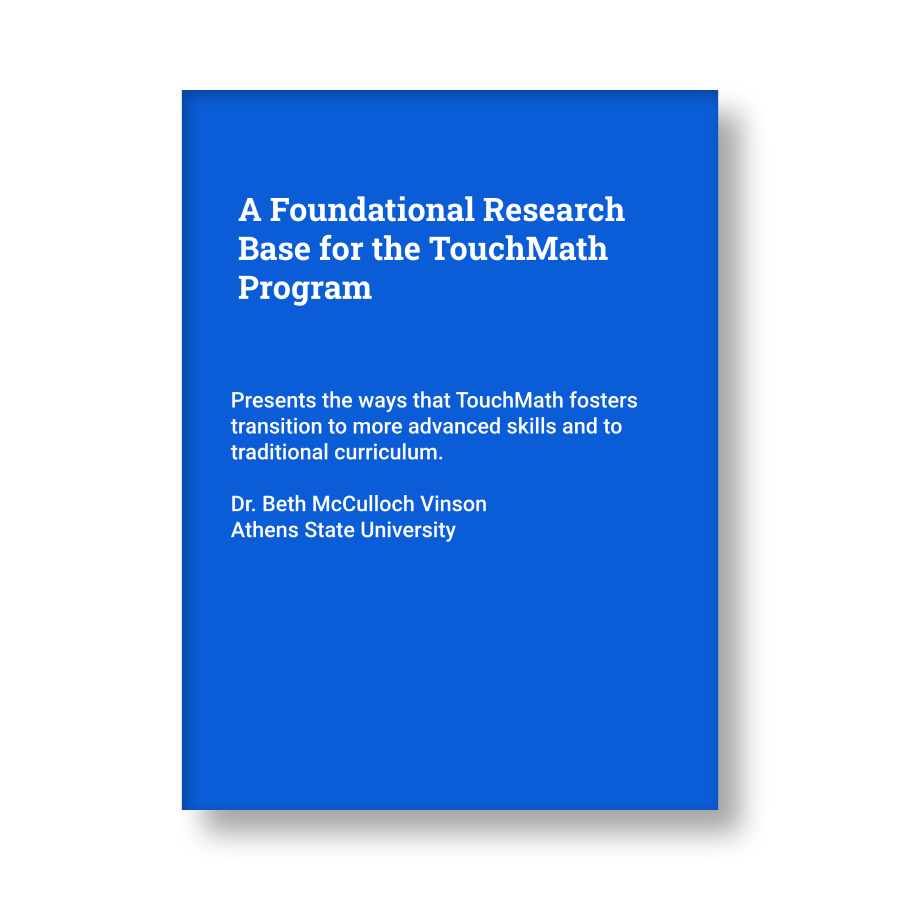
A Foundational Research Base for the TouchMath Program
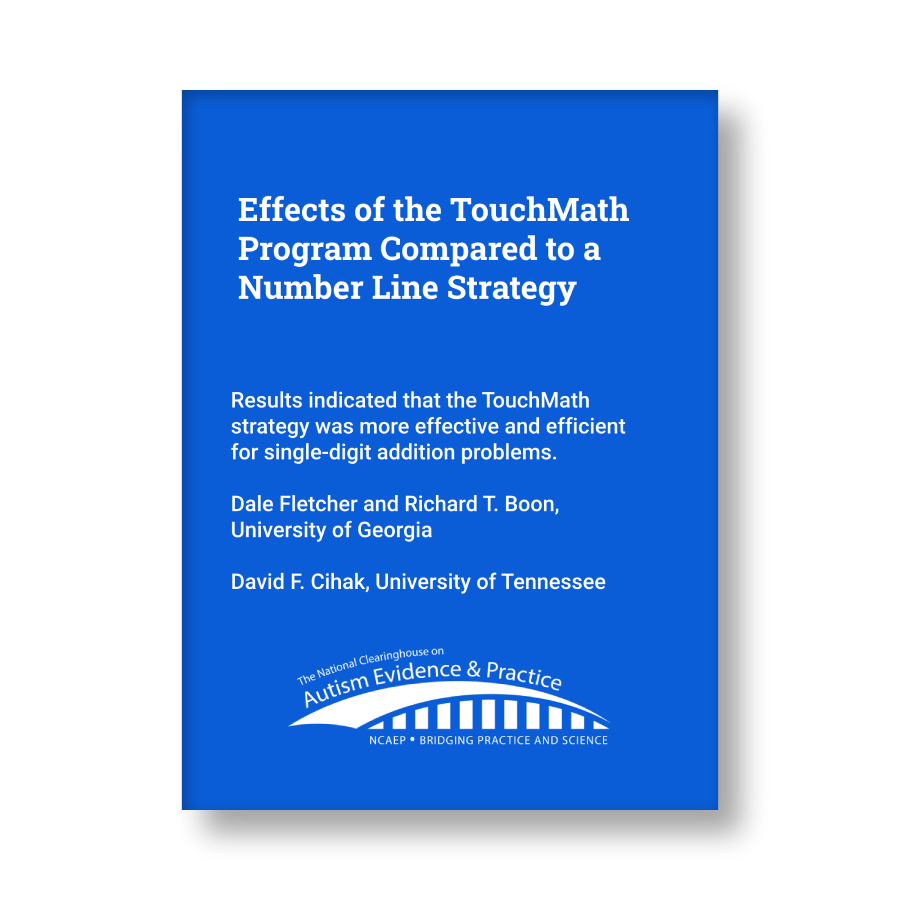
Effects of the TouchMath Program Compared to a Number Line Strategy
Results indicate that the TouchMath strategy was more effective for single-digit addition problems.
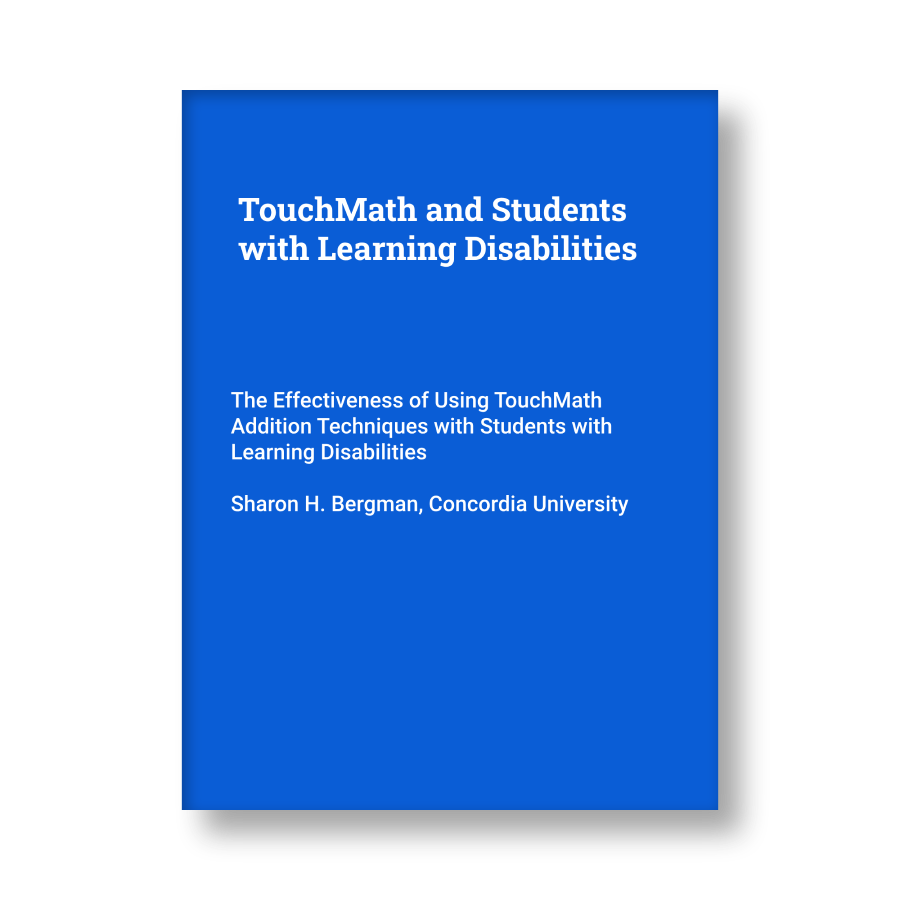
TouchMath and Students with Learning Disabilities
The study concludes that TouchMath is an effective technique as a multisensory method.
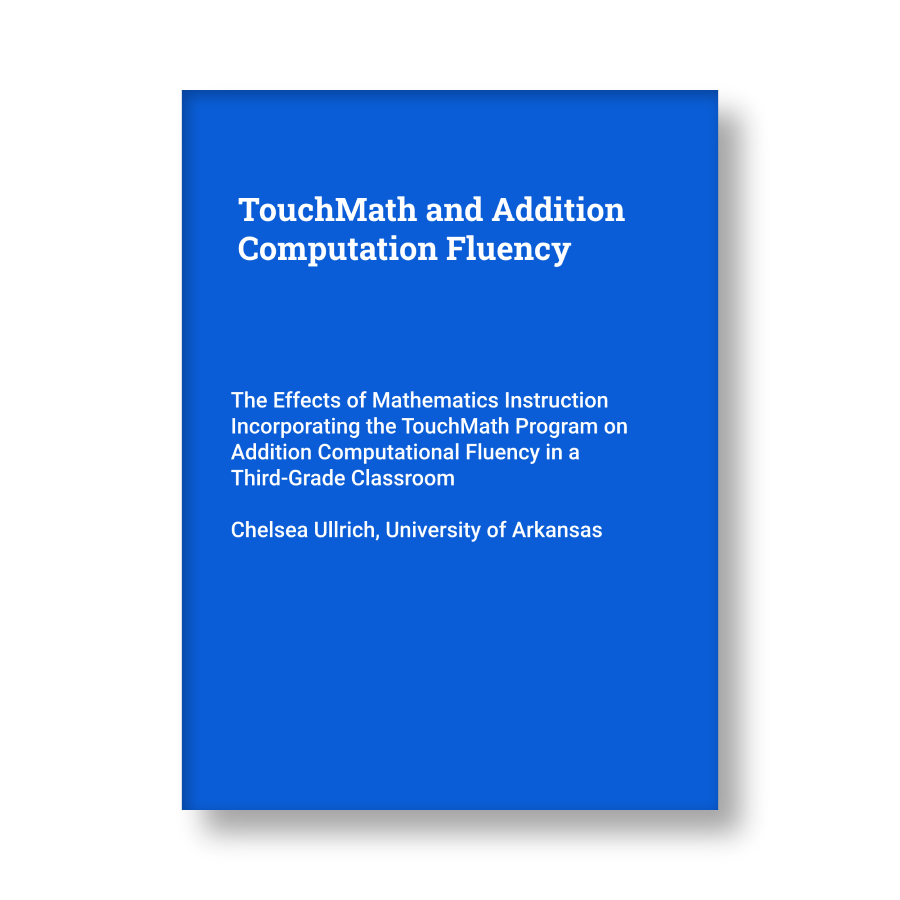
TouchMath and Addition Computation Fluency
Data shows TouchMath is effective for students needing support in mastering addition facts.
"The TouchMath program improves students' addition computational fluency."
The Effects of Mathematics Instruction Incorporating the TouchMath Program on Addition Computational Fluency in a Third-Grade Classroom
— C. Ullrich, M.A.T. University of Arkansas
“TouchMath can be the game-changer."
Our whitepaper summarizes all of the independent research conducted regarding TouchMath through 2025. You will find the complete case to be made for TouchMath in modern mainstream classrooms as a core, supplemental, or remedial math program.
Fill out the form to download the TouchMath whitepaper.
"TouchMath is a more effective method for teaching students with mild learning disabilities."
TouchMath Intervention vs. Traditional Intervention: Is There a Difference?
— D. Dulgarian, University of West Los Angeles
Research Being Processed by WWC
Park, J., Bassette, L., & Bouck, E. (2021). Using TouchMath to Teach Money Identification to Students with Autism Spectrum Disorders: A Brief Report. International Journal of Disability, Development and Education.
A multiple probe design across participants was used to evaluate students’ accuracy in solving money identification problems.
Results of the study demonstrated that two students showed intervention effects.
Nelson, J. (2019). An Investigation of the Effectiveness of TouchMath on Mathematics Achievement for Students with the Most Significant Cognitive Disabilities. Kansas State University.
The results of the study confirmed what previous studies on TouchMath had shown: that students made significant gains in the area of mathematical accuracy with single, 1- digit addition.
Uzomah, S. (2012). Teaching Mathematics to Kindergarten Students through a Multisensory Approach. Walden University.
Results of the statistical test demonstrated significantly higher gain score in mathematics achievement for those who were taught using the TouchMath program.
Avant, M. J. T., & Heller, K. W. (2011). Examining the effectiveness of TouchMath with students with physical disabilities. Remedial and Special Education, 32(4), 309-321.
The results indicated that students who have difficulty learning math skills may benefit from representational approaches, such as TouchMath.
Waters, H. E., & Boon, R. T. (2011). Teaching money computation skills to high school students with mild intellectual disabilities via the TouchMath program: A multi-sensory approach. Education and Training in Autism and Developmental Disabilities, 544-555.
The results of the multiple-probe across participants revealed that the TouchMath program improved all three of the students’ ability to subtract 3-digit mathematics operations using money applications.
Fletcher, D., Boon, R., Cihak, D. (2010). Effects of the “TOUCHMATH” Program compared to a number line strategy to teach addition facts to middle school students with moderate intellectual disabilities. Education and Training in Autism and Developmental Disabilities Vol. 45, No. 3 (September 2010), pp. 449-458.
Results of this study revealed that the students performed better using the TouchPoint strategy over the number line in acquiring single-digit addition problem-solving skills.
Cihak, D.F., & Foust, J.L. (2008). Comparing number lines and touch points to teach addition facts to students with autism. Focus on Autism and Other Developmental Disabilities, 23(3), 131-137.
The results indicated that the touch-point strategy was more effective in teaching single-digit addition digit schools. The touch- point strategy was then replicated using the non-preferred strategy’s content, improving all students’ addition skills.
Simon, R., & Hanrahan, J. (2007). An evaluation of the TouchMath method for teaching addition to students with learning disabilities in mathematics. European Journal of Needs Education, Vol. 19, No. 2, June, 2004, p91 – 209. Published online 28 June, 2007.
The results indicated that students with learning disabilities in mathematics were able to learn and generalize the dot-notation to solve three-row, double-digit addition problems requiring regrouping.
"...The results indicated that all three of the students were able to utilize the "touch point" strategy faster and more accurately than the number line intervention."
Effects of the "TOUCHMATH" Program compared to a number line strategy to teach addition facts to middle school students with moderate intellectual disabilities.
— D. Fletcher & R. Boon, University of Georgia and D. Chihak, University of Tennessee
Additional Research About TouchMath
Alghamdi, A.S. (2024). Evidence-based practices: using the touch points strategy to teach single-digit addition to students with ASD. Humanit Soc Sci Commun 11, 39.
The study conducted over 5 weeks employing an A-B-A-B reversal design, found that the touch-point strategy significantly improved the mathematical problem-solving skills of students with Autism Spectrum Disorder (ASD).
Urton, K., Grünke, M., & Boon, R. T. (2022). Using a Touch Point Instructional Package to Teach Subtraction Skills to German Elementary Students At-Risk for LD. International Electronic Journal of Elementary Education.
Findings showed that intervention using TouchPoints was effective to very effective to enhance the ability of students to solve subtraction problems.
Khalifa, A. G., & Saad, M. A. E. (2021). The Effectiveness of Touch Math on Improving Early Mathematics Ability of Kindergarten Children with Mild to Borderline Intellectual Functioning in an Inclusion Classroom. Journal of Intellectual Disability – Diagnosis and Treatment, 9(3), 189–194.
Findings revealed that TouchMath is effective, sustainable, generalizable, and socially valid in teaching basic addition skills to students with mild intellectual disabilities in inclusive general education classrooms.
Elawady Abdou, R. A. (2020). The effect of Touch Math multi-sensory program on teaching basic computation skills to young children identified as at risk for the acquisition of computation skills. Revista Amazonia Investiga, 9(27), 149–156.
Results of a two-way ANOVA and t-test indicated the effectiveness of the TouchMath multisensory program in addition and subtraction skills across 40 kindergarten students in two Cairo schools.
Taneja, K., & Sankhian, A. (2019). Effect of Multi-Sensory Approach on Performance in Mathematics at Primary Level. The Educational Beacon.
The results of the study confirmed what previous studies on TouchMath had shown: that students made significant gains in the area of mathematical accuracy with single digit addition.
Kot, M., Terzioğlu, N. K., Aktaş, B., & Yikmiş, A. (2018). Effectiveness of touch math technique: Meta-analysis study. European Journal of Special Education Research. ISSN 2582-3515 Vol. 8.
The findings of this research indicated that TouchMath is an effective method in teaching basic math skills to children with mental disabilities.
Ellingsen, E. & Clinton, E. (2017). Using the TouchMath Program to Teach Mathematical Computation to At-Risk Students and Students with Disabilities. Educational Research Quarterly , Vol. 41.1, September 2017, p15-40.
Findings revealed that TouchMath is an effective tool for teaching specific computational tasks to certain populations of learners. The dot notation system is likely useful for students who struggle with rote memorization because it provides a tool for calculating math algorithms if the correct response cannot be retrieved from memory.
Kot, Sonmez, Yikmis, & Cora-Ince. (2016). The Effectiveness of the Touch Math Technique to Teach in-hand Addition to Students with Hearing Impaired.
The results of the study yields that to use the TouchMath technique that is based on direct instruction approach to teach the basic summation skills to the hearing-impaired students that study in the mainstreaming classes is effective.
Yıkmış, A. (2016). Effectiveness of the touch math technique in teaching basic addition to children with autism. Educational Sciences: Theory & Practice, 16(3).
The results of the study show that the use of touch math technique, based on direct instruction approach is effective in teaching the basic summation skills to the students with mild intellectual disabilities.
Aydemir, T. (2015). A review of the articles about TouchMath, Procedia. Social and Behavioral Sciences 174, 1812–1819.
The review concluded that TouchMath is an effective technique as a multisensory method and should be accepted as a research- based technique to teach number sense and four operation skills.
ValindaJo Valentina Barkley & Dr. Maureen Gerard, Ph.D (2014). TOUCHMATH: IS IT AN EFFECTIVE, DEVELOPMENTALLY APPROPRIATE INTERVENTION FOR PRESCHOOLERS?
The results of the study determined if TouchMath is used for PreK, it would be best introduced in the spring or at the end of the year to give the students time to mature and socially bond.
Wakeman, S., Karvonen, M., & Ahumada, A. (2013). Changing instruction to increase achievement for students with moderate to severe intellectual disabilities. Teaching Exceptional Children, 46(2), 6-13.
This article supports teachers’ ability to adjust how they will deliver instruction to effectively respond whenever students are not experiencing success. Findings indicated that TouchMath is an effective method for teaching mod- severe students.
Calik, C., & Kargin, T. (2010). Effectiveness of the Touch Math Technique in Teaching Addition Skills to Students with Intellectual Disabilities. International Journal of Special Education, v25 n1 p195-204.
The results of the study showed that the use of touch math technique, based on direct instruction approach is effective in teaching the basic summation skills to the students with mild intellectual disabilities.
Green, N. D. (2009). The Effectiveness of the Touch Math Program with Fourth and Fish Grade Special Education Students. Western Governors University.
The results indicated an increase in math achievement in third and fourth grade Special Education students, on both the teacher- made test as well as the TOMA-2. Students also showed a decrease in avoidance behavior and frustration.
Mays, D. (2008). TouchMath: An Intervention that Works
The research indicated that TouchMath is an effective approach for teaching addtion to learners in general education and special education contexts.
Vinson, B., M. (2005). Touching Points on a Numeral as a Means of Early Calculation: Does this Method Inhibit Progression to Abstraction and Fact Recall? Athens State University.
Research involving 722 adult respondents, who are successful at higher mathematics, indicated that counting and using strategies such as those presented by TouchMath have provided an important foundation for their success.
Vinson, B., M. (2004). A foundational research base for the TouchMath program. Athens State University.
Findings showed that TouchMath helps children with numbers, numerals, number words, counting, cardinal number, numeration skills, recalling basic facts, communication, addition, subtraction, multiplication, and division. The relationship between two systems, Braille and TouchPoints, were linked as effective symbolic representation systems.
Wisniewski, Z., G., Smith, D. (2002). How effective is TouchMath for improving students with special needs academic achievement on math addition mad-minute timed tests. Indiana University South Bend.
All students involved in the study showed significant improvement in both speed and accuracy from pre-test to post-test, which supported the effectiveness of the TouchMath intervention.
Dev, P., C., Doyle, B., A., & Valente, B. (2002) Labels Needn’t Stick: “At-Risk” First Graders Rescued With Appropriate Intervention. Journal of Education for Students Placed At Risk, 7:3, 327-332, DOI: 10.1207/S15327671ESPR0703_3.
After 2 years of the intervention, which included TouchMath, the participants were found to be no longer in need of special education services.
Barry, D. (2001). An investigation of the effectiveness of TouchMath on elementary students with autism. Claremount Graduate University.
The results of the study indicated that using TouchMath led to an increase of math fluency, with students experiencing learnings gains in addition and subtraction skills.
Connect with Your Local Account Manager
Select your state below to schedule a 30-min demo with your Account Manager .
